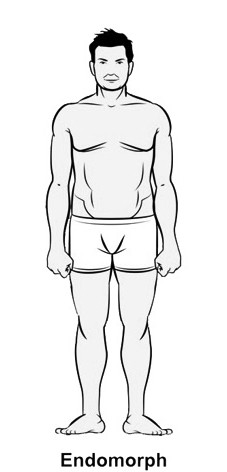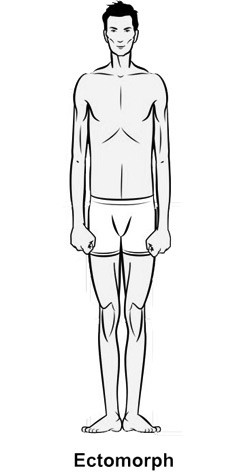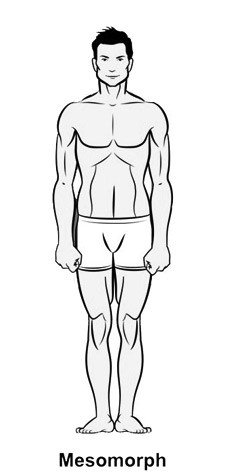Metabolic Body Types

July 10, 2024
No two human bodies are identical. We are different.
Human bodies come in various shapes and sizes, each with varying metabolic characteristics. Body type can be influenced by factors under our control like lifestyle and environment. However, body type is driven mainly by factors beyond our control such as genetics. A popular way to categorize body types is the somatotype system, which classifies physiques into three primary categories: ectomorph, endomorph, and mesomorph. Understanding body type can help us understand our differences and manage our metabolic risk factors.
Most importantly, knowing our body type can help us understand our unique advantages and disadvantages, strategies that will be successful, and approaches that are likely to fail.
Endomorph
I always knew I was different from a child. It was easy for me to gain weight and difficult to lose weight. Playing athletics, my ‘friends’ would joke that every season I would have to “burn off the baby fat” and get back in shape – which usually involved some sort of starvation and hours of cardio. Gaining strength was easy for me, but my talent for gaining fat was world class. After decades of tracking my calories and exercise in effort to meet illusive standards set for me by others, I remembered that I am different and changed my strategies. I am an endomorph.
Characteristics:

- Naturally broader and rounder
- Slower metabolism
- Higher body fat percentage
- Easier weight gain, particularly fat
- Often struggle with insullin resistance, obesity and metabolic syndrome
- Metabolism easily slows to offset traditional low fat diets
- Strategies will focus on body fat for fuel while building strength
Tendencies:
Endomorphs have a predisposition to store fat and often have a higher percentage of body fat compared to the other body types. They tend to gain weight easily and may struggle with losing it due to their slower metabolism. This body type is more likely to be obese if caloric intake is not carefully managed and physical activity is limited.
Ectomorph
For me, staying in playing shape during basketball season was brutally hard and meant constant conditioning while watching every ounce of what I consumed. At the same time a friend of mine, Dan Moore, could fill his plate with prolific amounts of food, refill it at times, always clean his plate, and rarely ever gain a pound. He was in good aerobic condition, but putting on weight for sports such as football or wrestling would have been a struggle for Dan. I came to realize that Dan and I are different. Dan is an ectomorph.
Characteristics:

- Naturally lean and slender
- Fast metabolism
- Narrow frame with small joints and long limbs
- Difficulty gaining weight and muscle mass
- Rarely struggle with obesity and metabolic syndrome
- Metabolism adjusts to absorb nutrition at all levels
- Strategies will focus primarily on building strength
Tendencies:
Ectomorphs are often seen as the “hard gainers” because their fast metabolism makes it challenging to gain weight, whether it’s fat or muscle. They can consume a significant amount of calories without gaining much weight. This body type is less likely to struggle with obesity due to their efficient metabolism and difficulty storing fat.
Mesomorph
We think of most elite athletes as genetically gifted. Their bodies are different. They can respond to various types of training well. They gain strength easily. Their conditioning is robust. I played basketball with a few elite athletes. Many of them were hard workers in the gym and at the supper table. Their bodies reacted beautifully to small variations in diet and exercise. They are mesomorphs.
Characteristics:

- Naturally muscular and well-built
- Efficient metabolism
- Broad shoulders, narrow waist
- Easily gains muscle and maintains a balanced weight
- Infrequently challenged by metabolic syndrome
- Metabolism can be altered by activity levels and nutrition
- Strategies will focus on fat-burning metabolism
Tendencies:
Mesomorphs are often considered the genetically gifted body type for fitness, as they gain muscle easily and maintain a relatively low body fat percentage. While mesomorphs have a more balanced metabolism, they can still gain weight if their diet is not controlled. However, they are less likely to become obese compared to endomorphs due to their propensity for muscle growth and balanced metabolism.
Measuring Somatotype
Somatotype can be measured using the Heath-Carter measurement system, in which ratings for endomorphy, mesomorphy and ectomorphy are calculated using biometric measurements in conjunction with photos. A person is classified on a scale from 1 to 7 (though higher ratings are possible) in each somotype. While numbers may seem appealing, the Heath-Carter system has many challenges in measurement. For most, the Catudel and Colino questionairre would be sufficient to confirm your body type. In my case, for example, the 10 short questions confirm that I am 100% endomorph.
Endomorphs and Metabolic Syndrome
Higher Body Fat Percentage: Endomorphs naturally have a higher body fat percentage, particularly around the abdominal area. This central obesity is a significant risk factor for metabolic syndrome.
Insulin Resistance: Endomorphs are more prone to insulin resistance, a condition where the body’s cells do not respond effectively to insulin. Insulin resistance can lead to higher blood sugar levels and eventually type 2 diabetes, a component of metabolic syndrome.
Slower Metabolism: A slower metabolism can contribute to weight gain and difficulty losing weight, further increasing the risk of metabolic syndrome. Excess weight, especially around the abdomen, is closely linked to the development of this syndrome.
Inflammation: Higher levels of body fat, especially visceral fat (fat around the organs), are associated with increased inflammation in the body. Chronic inflammation is a contributing factor to many conditions that are part of metabolic syndrome, including atherosclerosis and hypertension.
Managing Metabolic Syndrome
Individuals with an endomorph body type can take several steps to reduce their risk of developing metabolic
syndrome:
Diet and Exercise: While there are many nutritional approaches to metabolic syndrome, a ketogenic (high fat low carbohydrate) diet has been recommended for endomorphs since the 1950’s. You will find many great exercise ideas on this website including an approach to both cardio and weightlifting activities to burn fat and build healthy muscle tissue.
Stress Management: Chronic stress can contribute to weight gain and metabolic disturbances. Incorporating stress-reducing activities such as meditation, yoga, or deep breathing exercises can be beneficial.
Regular Health Check-ups: Regular monitoring of blood pressure, blood sugar levels, and cholesterol levels can help detect early signs of metabolic syndrome. Early intervention can prevent or delay the development of more serious health issues.
Conclusion
We all have different metabolic body types. Understanding metabolic body type can help us understand our unique strengths and challenges. You can begin to understand why you cannot successfully deploy advice given to you by other experts. The reason is that they have not taken time to consider your unique metabolic profile and related needs. Endomorphs have a higher predisposition to insullin resistance, obesity and metabolic syndrome which are often related to genetic factors. Mesomorphs can struggle with metabolic syndrome when challenge arise mostly from environmental facts. Ectomorphs rarely struggle with obesity or metabolic syndrome.
Additional Reading
- Catudal P, Colino S Do You Know Your Body Type?. EveryDayHealth.com. Updated November 16, 2023.
- Després JP, Lemieux I. Abdominal Obesity and Metabolic Syndrome. Nature. 2006;444(7121):881-887.
- Galic BS, et al. Somatotype characteristics of normal-weight and obese women among different metabolic subtypes. Arch Endocrinol Metab. 2016 Feb;60(1):60-5.
- Grundy SM, Brewer HB Jr, Cleeman JI, Smith SC Jr, Lenfant C. Definition of Metabolic Syndrome: Report of the National Heart, Lung, and Blood Institute/American Heart Association Conference on Scientific Issues Related to Definition. Circulation. 2004;109(3):433-438.
- Heymsfield SB, Lohman TG, Wang Z, Going SB. Human Body Composition. 2nd ed. Champaign, IL: Human Kinetics; 2005.
- Kaur J. A Comprehensive Review on Metabolic Syndrome. Cardiol Res Pract. 2014;2014:943162.
- Robert Wood, Measuring Somatotype. Topend Sports Website. 2008.